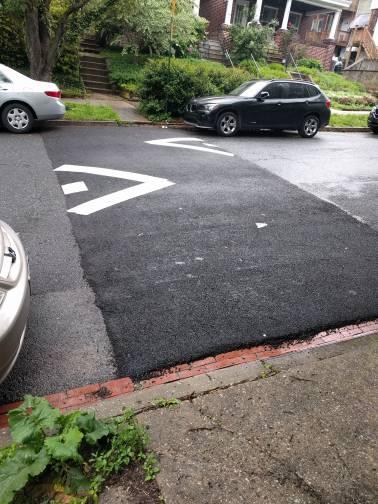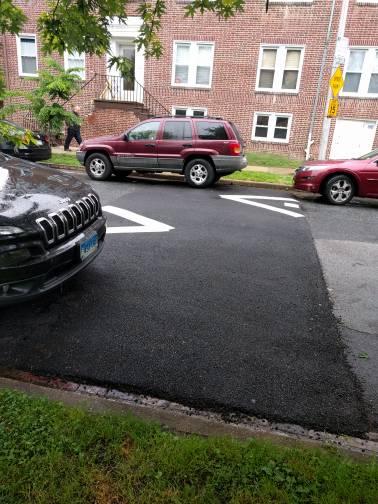This Saturday Baltimore City DOT will close down 32nd street and Guilford Avenue from 7am to 3pm to remove a debated traffic circle at the busy intersection. Neighbors complained that the small traffic circle did little to slow heavy traffic, and made the intersection unsafe for pedestrians.
Guilford Avenue received a bike boulevard treatment in 2011. The treatment included traffic circles at various intersections, sharrows, and bike friendly speed humps throughout the avenue from University Parkway to Mt. Royal Avenue. Even in its imperfect state, the low stress route has become a popular and necessary north/south connector for bicyclists, with ridership increasing dramatically on the corridor after installation and growing annually since. There was always talk about adding various improvements, but little was added after the first phase of construction.
When community meetings were first held in 2010, residents were shown photos of similar traffic calming treatments from around the country. Circles featured vertical treatments like plantings or sculptures. As neighbors began taking ownership of these new public spaces, DOT responded by banning any vertical treatments citing safety issues with emergency vehicles being able to pass through intersections. This policy decision grossly undermined the effectiveness of the circles.
32nd and Guilford Traffic Circle
A traffic circle in Minneapolis on a similar sized street to Guilford Ave
32nd Street leads to a very popular pocket park just East of Guilford Avenue. Pedestrian safety is paramount, as many families in the neighborhood walk through this intersection during the evening rush hour to play in the park. East bound car commuters like to use 32nd Street as a cut-through to avoid waiting on the light cycle at 33rd Street and Greenmount Avenue.
When several members of the Abell Community Association reached out last summer to get Bikemore's opinion on solutions to the unsafe intersection, we made the following recommendations to DOT:
- Remove four parking spots to increase the size of the crosswalks and re-stripe larger crosswalks to improve visibility.
- Create vertical elements and reflective signage in the traffic circle so that these visual elements slow traffic.
- Create a concrete "channel" or small median leading up to the circle that makes the turning radius narrow and expands the footprint of the circle, again slowing traffic.
- Install bike friendly speed humps (humps with small channels for bikes to pass through) leading up to the intersection in all directions.
Despite DOT staff supporting our recommendations, and working with us to remove the policy that restricted vertical elements in the circle, several neighbors chose to instead advocate for removal of the circle and installation of a four-way stop.
Bikemore attempted to persuade these neighbors to reconsider by offering a small grant to assist with adding plantings to the circle. We have since learned that these neighbors held a meeting in the field last fall with Councilwoman Mary Pat Clarke and Former DOT Director William Johnson, where they demanded removal of the circle and installation of the four-way stop. Councilwoman Clarke was not made aware by these neighbors or Director Johnson that a different treatment was recommended by Bikemore and DOT's traffic and bicycle staff.
While we worked to stay informed about the project through December, communication from DOT eventually dropped off.
So you can imagine our surprise when a few weeks ago four new stop signs were installed. This countered our recommendations to maintain the spirit of the bike boulevard, while addressing residents' very valid concerns of pedestrian safety and traffic speeds. Furthermore, not being able to review plans and weigh in on changes to one of the city's only decent bike facilities felt like a slap in the face--especially when the direction of this project could have been easily raised in any of the multiple meetings we've had with employees involved since we last spoke about it in December.
In so many ways 2016 is truly the Year of the Bike in Baltimore. Construction begins on Maryland Avenue and many additional elements of the Downtown Bike Network in late June. Bike Share will launch this fall. The city keeps pursuing--and winning--grant dollars for projects to improve bike connectivity. So why insist as an agency on taking two steps back with each step forward?
According to an email we received from Councilwoman Clarke, neighbors in the Abell Community advocated for bike friendly speed humps in conjunction with the four way stop, and of course as seen in the photos of the new treatment, standard speed humps were installed. DOT cannot even use their standard excuse of responding to neighborhood pressure, because even the neighbors didn't get exactly what they requested.
If DOT continues to make decisions that either don't consider neighbors' concerns, or only listen to a vocal minority, decisions that ignore our city's complete street policy, that erode hard won trust between the biking community--which public are they serving?
This is why it is absolutely critical we begin to codify and enforce transportation policy that prioritizes the safety of human beings over car traffic throughput. It is essential we develop ways our Mayor and City Council can hold DOT employees accountable when they willfully ignore the requests of Baltimore residents.
They made a choice to prioritize four personal car parking spaces over maintaining one of the only comfortable bike facilities in our city, used by hundreds of riders daily. They made a choice to not give the neighborhood the best design available by listening to a vocal minority, and then failed even that vocal minority by not installing the specific facility they requested because of apathy and unwillingness. And because of these choices, those walking through the intersection were not given the best possible solution for improving pedestrian safety.
Want to let DOT and Councilwoman Mary Pat Clarke know you'd prefer to see improvements to bike infrastructure versus removal?
Use our handy email tool and say your peace with just a few clicks.












